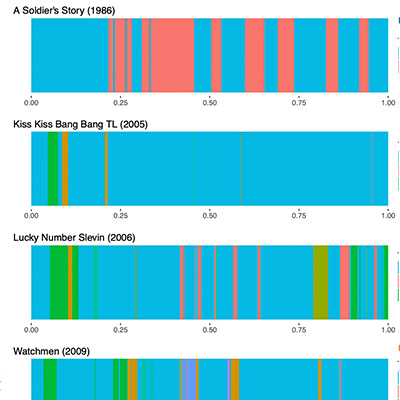Broken Time, Continued Evolution: Anachronies in Contemporary Films
About the project
Status: archive
Project team: Oleg Sobchuk;
Collaborators: Maria Kanatova, Alexandra Milyakina, Tatyana Pilipovec, Artjom Shelya, Peeter Tinits;
End date: Apr 1, 2017

Between the 1980's and 2000's, anachronies (flashbacks / flashforwards) became a trademark of a new genre of film ("modular narratives", "puzzle films"), and have found their way into other genres as well. This project aimed to quantify the increase beyond anecdote, examine the degree to which the increase in anachronies has a qualitative impact on the films, and speculate on the driving force for this trend.
To gather a corpus, the project turned to IMDbPro, which offers a metric called MOVIEmeter that constructs a sample with highest rated films among the most popular films in the database. In addition, the project focused on detective movies: movies where plot is used as a device to structure temporality (e.g. excluding action movies where plot is a container for a succession of fights or car crashes.) For temporal and geographic scope, the collection was limited to films produced in the USA between the 1970's and 2000's.
The project found there was more variation in the data between the 1990's and 2000's in terms of number of anachronies per hour, and identified three clusters of detective films, based on their use of anachronies. The anachronies were charted within film-time; in the "conservative" group, most anachronies occur in the first 20% or last 30% as a framing device; the films that use them more extensively also have a more even distribution of anachronies. As to the motivation for the increase in anachronies in the 1990's, the project points to a new use for an old device. Around this time, there was a tremendous increase in the number of mystery films released -- much as there was an increase in the number of mystery novels at the end of the 19th century. In the case of mystery novels, the order in which events are presented in a narrative can trigger suspense, curiosity, and surprise. Anachronies in film can play a similar role in introducing "information gaps" that contribute to the viewer's curiosity, and the project found, indeed, that the rise of the highly-anachronistic movie corresponded with the rise of "multi-protagonist" films.